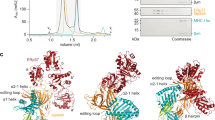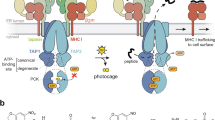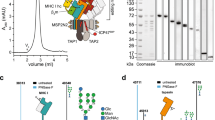Abstract
Major histocompatibility complex (MHC) class I glycoproteins bind peptides in the endoplasmic reticulum after incorporation into the peptide-loading complex, whose core is the transporter associated with antigen processing. Other components are the chaperone calreticulin, the thiol oxidoreductase ERp57, and tapasin. Tapasin and ERp57 have been shown to exist in the peptide-loading complex as a disulfide-linked heterodimer. Here, using a cell-free system, we demonstrate that although recombinant tapasin was ineffective in recruiting MHC class I molecules and facilitating peptide binding, recombinant tapasin-ERp57 conjugates accomplished both of those functions and also 'edited' the repertoire of bound peptides to maximize their affinity. Thus, the tapasin-ERp57 conjugate is the functional unit of the peptide-loading complex that generates MHC class I molecules with stably associated peptides.
This is a preview of subscription content, access via your institution
Access options
Subscribe to this journal
Receive 12 print issues and online access
$209.00 per year
only $17.42 per issue
Buy this article
- Purchase on Springer Link
- Instant access to full article PDF
Prices may be subject to local taxes which are calculated during checkout





Similar content being viewed by others
Change history
13 July 2007
In the version of this article initially published online, the right side of Figure 1c was cut off. The error has been corrected for all versions of the article.
References
Cresswell, P., Ackerman, A.L., Giodini, A., Peaper, D.R. & Wearsch, P.A. Mechanisms of MHC class I-restricted antigen processing and cross-presentation. Immunol. Rev. 207, 145–147 (2005).
Momburg, F. & Tan, P. Tapasin-the keystone of the loading complex optimizing peptide binding by MHC class I molecules in the endoplasmic reticulum. Mol. Immunol. 39, 217–233 (2002).
Bangia, N., Lehner, P.J., Hughes, E.A., Surman, M. & Cresswell, P. The N-terminal region of tapasin is required to stabilize the MHC class I loading complex. Eur. J. Immunol. 29, 1858–1870 (1999).
Garbi, N., Tiwari, N., Momburg, F. & Hammerling, G.J. A major role for tapasin as a stabilizer of the TAP peptide transporter and consequences for MHC class I expression. Eur. J. Immunol. 33, 264–273 (2003).
Sadasivan, B., Lehner, P.J., Ortmann, B., Spies, T. & Cresswell, P. Roles for calreticulin and a novel glycoprotein, tapasin, in the interaction of MHC class I molecules with TAP. Immunity 5, 103–114 (1996).
Lehner, P.J., Surman, M.J. & Cresswell, P. Soluble tapasin restores MHC class I expression and function in the tapasin-negative cell line .220. Immunity 8, 221–231 (1998).
Tan, P. et al. Recruitment of MHC class I molecules by tapasin into the transporter associated with antigen processing-associated complex is essential for optimal peptide loading. J. Immunol. 168, 1950–1960 (2002).
Schoenhals, G.J. et al. Retention of empty MHC class I molecules by tapasin is essential to reconstitute antigen presentation in invertebrate cells. EMBO J. 18, 743–753 (1999).
Barnden, M.J., Purcell, A.W., Gorman, J.J. & McCluskey, J. Tapasin-mediated retention and optimization of peptide ligands during the assembly of class I molecules. J. Immunol. 165, 322–330 (2000).
Grandea, A.G., III et al. Impaired assembly yet normal trafficking of MHC class I molecules in tapasin mutant mice. Immunity 13, 213–222 (2000).
Greenwood, R., Shimizu, Y., Sekhon, G.S. & DeMars, R. Novel allele-specific, post-translational reduction in HLA class I surface expression in a mutant human B cell line. J. Immunol. 153, 5525–5536 (1994).
Garbi, N. et al. Impaired immune responses and altered peptide repertoire in tapasin-deficient mice. Nat. Immunol. 1, 234–238 (2000).
Carreno, B.M. et al. TAP associates with a unique class I conformation, whereas calnexin associates with multiple class I forms in mouse and man. J. Immunol. 155, 4726–4733 (1995).
Grandea, A.G., III, Lehner, P.J., Cresswell, P. & Spies, T. Regulation of MHC class I heterodimer stability and interaction with TAP by tapasin. Immunogenetics 46, 477–483 (1997).
Owen, B.A.L. & Pease, L.R. TAP association influences the conformation of nascent MHC class I molecules. J. Immunol. 162, 4677–4684 (1999).
Myers, N.B. et al. Kb, Kd and Ld molecules share common tapasin dependencies as determined using a novel epitope tag. J. Immunol. 165, 5656–5663 (2000).
Williams, A.P., Peh, C.A., Purcell, A.W., McCluskey, J. & Elliott, T. Optimization of the MHC class I peptide cargo is dependent on tapasin. Immunity 16, 509–520 (2002).
Howarth, M., Williams, A., Tolstrup, A.B. & Elliott, T. Tapasin enhances MHC class I peptide presentation according to peptide half-life. Proc. Natl. Acad. Sci. USA 101, 11737–11742 (2004).
Elliott, T. & Williams, A. The optimization of peptide cargo bound to MHC class I molecules by the peptide-loading complex. Immunol. Rev. 207, 89–99 (2005).
Zarling, A.L. et al. Tapasin is a facilitator, not an editor, of class I MHC peptide binding. J. Immunol. 171, 5287–5295 (2003).
Garbi, N., Hammerling, G. & Tanaka, S. Interaction of ERp57 and tapasin in the generation of MHC class I-peptide complexes. Curr. Opin. Immunol. 19, 99–105 (2007).
Dick, T.P., Bangia, N., Peaper, D.R. & Cresswell, P. Disulfide bond isomerization and the assembly of MHC class I-peptide complexes. Immunity 16, 87–98 (2002).
Peaper, D.R., Wearsch, P.A. & Cresswell, P. Tapasin and ERp57 form a stable disulfide-linked dimer within the MHC class I peptide-loading complex. EMBO J. 24, 3613–3623 (2005).
Ellgaard, L. & Ruddock, L.W. The human protein disulphide isomerase family: substrate interactions and functional properties. EMBO Rep. 6, 28–32 (2005).
Walker, K.W. & Gilbert, H.F. Scanning and escape during protein-disulfide iosmerase-assisted folding. J. Biol. Chem. 272, 8845–8848 (1997).
Garbi, N., Tanaka, S., Momburg, F. & Hammerling, G.J. Impaired assembly of the major histocompatibility complex class I peptide-loading complex in mice deficient in the oxidoreductase ERp57. Nat. Immunol. 7, 93–102 (2006).
Frickel, E.M. et al. TROSY-NMR reveals interaction between ERp57 and the tip of the calreticulin P-domain. Proc. Natl. Acad. Sci. USA 99, 1954–1959 (2002).
Wearsch, P.A. et al. Major histocompatibility complex class I molecules expressed with monoglucosylated N-linked glycans bind calreticulin independently of their assembly status. J. Biol. Chem. 279, 25112–25121 (2004).
Helenius, A. & Aebi, M. Roles of N-linked glycans in the endoplasmic reticulum. Annu. Rev. Biochem. 73, 1019–1049 (2004).
Kjer-Nielsen, L. et al. The structure of HLA-B8 complexed to an immunodominant viral determinant: Peptide-induced conformational changes and a mode of MHC class I dimerization. J. Immunol. 169, 5153–5160 (2002).
Sutton, J. et al. A sequence pattern for peptides presented to cytotoxic T lymphocytes by HLA-B8 revealed by analysis of epitopes and elutes peptides. Eur. J. Immunol. 23, 447–453 (1993).
Wei, M.L. & Cresswell, P. HLA-A2 molecules in an antigen-processing mutant cell contain signal sequence-derived peptides. Nature 356, 443–446 (1992).
Chen, M. & Bouvier, M. Analysis of interactions in a tapasin/class I complex provides a mechanism for peptide selection. EMBO J. 26, 1681–1690 (2007).
Rizvi, S.M. & Raghavan, M. Direct peptide-regulatable interactions between MHC class I molecules and tapasin. Proc. Natl. Acad. Sci. USA 103, 18220–18225 (2006).
Neefjes, J.J., Hammerling, G.J. & Momburg, F. Folding and assembly of major histocompatibility complex class I heterodimers in the endoplasmic reticulum of intact cells precedes the binding of peptide. J. Exp. Med. 178, 1971–1980 (1993).
Stratikos, E., Wiley, D.C. & Stern, L.J. Enhanced catalytic action of HLA-DM on the exchange of peptides lacking backbone hydrogen bonds between their N-terminal region and the MHC class II α-chain. J. Immunol. 172, 1109–1117 (2004).
Narayan, K. et al. HLA-DM targets the hydrogen bond between the histidine at position β81 and peptide to dissociate HLA-DR-peptide complexes. Nat. Immunol. 8, 92–100 (2007).
Lewis, J.W., Neisig, A., Neefjes, J. & Elliott, T. Point mutations in the α2 domain of HLA-A2.1 define a functionally relevant interaction with TAP. Curr. Biol. 6, 873–883 (1996).
Warburton, R.J. et al. Mutation of the α2 domain disulfide bridge of the class I HLA-A*0201. Effect on maturation and peptide presentation. Hum. Immunol. 39, 261–271 (1994).
Park, B. et al. Redox regulation facilitates optimal peptide selection by MHC class I during antigen processing. Cell 127, 369–382 (2006).
Peh, C.A. et al. HLA-B27-restricted antigen presentation in the absence of tapasin reveals polymorphism in mechanisms of HLA class I peptide loading. Immunity 8, 531–542 (1998).
Diedrich, G., Bangia, N., Pan, M. & Cresswell, P. A role for calnexin in the assembly of the MHC class I loading complex in the endoplasmic reticulum. J. Immunol. 166, 1703–1709 (2001).
Lutz, P.M. & Cresswell, P. An epitope common to HLA class I and class II antigens, Ig light chains, and β2-microglobulin. Immunogenetics 25, 228–233 (1987).
Parham, P., Barnstable, C.J. & Bodmer, W.F. Use of a monoclonal Ab (W6/32) in structural studies of HLA-A,B,C antigens. J. Immunol. 123, 342–349 (1979).
Burrows, S.R., Sculley, T.B., Misko, I.S., Schmidt, C. & Moss, D.J. An Epstein-Barr virus-specific cytotoxic T cell epitope in EBV nuclear antigen (EBNA 3). J. Exp. Med. 171, 345–349 (1990).
Jardetzky, T.S., Lane, W.S., Robinson, R.A., Madden, D.R. & Wiley, D.C. Identification of self peptides bound to purified HLA-B27. Nature 353, 326–329 (1991).
Bertoletti, A. et al. Definition of a minimal optimal cytotoxic T-cell epitope within the hepatitis B virus nucleocapsid protein. J. Virol. 67, 2376–2380 (1993).
Jensen, P.E., Moore, J.C. & Lukacher, A.E. A europium fluoroimmunoassay for measuring peptide binding to MHC class I molecules. J. Immunol. Methods 215, 71–80 (1998).
Acknowledgements
We thank D. Peaper for discussions and critical review of the manuscript; S. Mitchell, R. Teel and A. Little for technical assistance; and N. Dometios for aid in preparing this manuscript. Supported by the Howard Hughes Medical Institute.
Author information
Authors and Affiliations
Contributions
P.A.W. designed and implemented all experiments; P.A.W. and P.C. wrote the paper.
Corresponding author
Ethics declarations
Competing interests
The authors declare no competing financial interests.
Rights and permissions
About this article
Cite this article
Wearsch, P., Cresswell, P. Selective loading of high-affinity peptides onto major histocompatibility complex class I molecules by the tapasin-ERp57 heterodimer. Nat Immunol 8, 873–881 (2007). https://doi.org/10.1038/ni1485
Received:
Accepted:
Published:
Issue Date:
DOI: https://doi.org/10.1038/ni1485
This article is cited by
-
Introducing Molecular Chaperones into the Causality and Prospective Management of Autoimmune Hepatitis
Digestive Diseases and Sciences (2023)
-
Molecular basis of MHC I quality control in the peptide loading complex
Nature Communications (2022)
-
Structure of an MHC I–tapasin–ERp57 editing complex defines chaperone promiscuity
Nature Communications (2022)
-
Exchange catalysis by tapasin exploits conserved and allele-specific features of MHC-I molecules
Nature Communications (2021)
-
Peptide exchange on MHC-I by TAPBPR is driven by a negative allostery release cycle
Nature Chemical Biology (2018)



